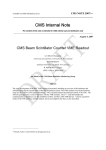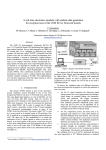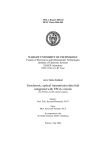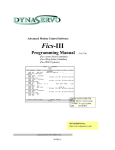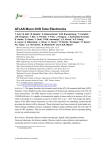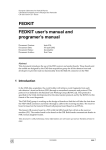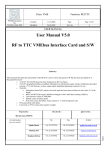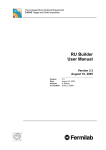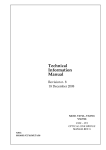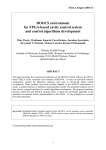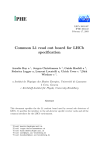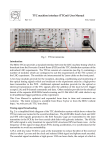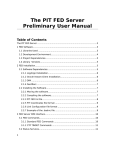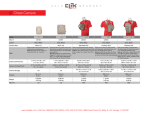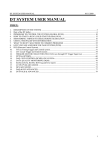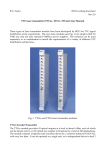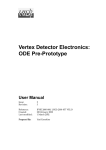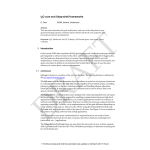Download LAPPEENRANTA UNIVERSITY OF TECHNOLOGY Department of
Transcript
LAPPEENRANTA UNIVERSITY OF TECHNOLOGY Department of Electrical Engineering MASTER’S THESIS MUON DETECTOR LINK SYSTEM TEST SET-UP The topic of the Master's thesis has been approved by the department council of the Department of Electrical Engineering on 9 November 2005. The supervisors and examiners of the thesis are Professor Tuure Tuuva and M.Sc. (Tech.) Matti Iskanius. Lappeenranta 21.11.2005 Vesa Väisänen Korpimetsänkatu 5 C 2 53850 Lappeenranta Finland +358 50 413 2581 TIIVISTELMÄ Tekijä: Vesa Väisänen Työn nimi: Myoni-ilmaisimen linkkijärjestelmän testiympäristö Osasto: Sähkötekniikka Vuosi: 2005 Paikka: Lappeenranta Diplomityö. Lappeenrannan teknillinen yliopisto. 53 sivua, 31 kuvaa, 3 taulukkoa ja 4 liitettä. Tarkastajat: Professori Tuure Tuuva ja DI Matti Iskanius Hakusanat: myoni, CMS, RPC, DCS CERNin tutkimuskeskuksen rakenteilla olevan hadronikiihdyttimen eräs tarkoitus on todistaa Higgsin bosonin olemassaolo. Higgsin bosonin löytyminen yhtenäistäisi nykyisen hiukkasfysiikan teorian ja antaisi selityksen sille kuinka hiukkaset saavat massansa. Kiihdyttimen CMS koeasema on tarkoitettu erityisesti myonien ilmaisuun. Tämä työ liittyy CMS koeaseman RPC-ilmaisintyypin linkkijärjestelmään, jonka tarkoituksena on käsitellä ilmaisimelta tulevia myonien aiheuttamia signaaleja ja lähettää tiedot tärkeäksi katsotuista törmäystapahtumista tallennettavaksi analysointia varten. Työssä on toteutettu linkkijärjestelmän ohjaus- ja linkkikorteille testiympäristö, jolla voidaan todeta järjestelmän eri osien keskinäinen yhteensopivuus ja toimivuus. Työn alkuosassa esitellään ilmaisimen linkkijärjestelmän eri osat ja niiden merkitykset. Työn loppuosassa käydään läpi eri testimenetelmiä ja analysoidaan niiden antamia tuloksia. ABSTRACT Author: Vesa Väisänen Title: Muon detector link system test set-up Department: Electrical Engineering Year: 2005 Place: Lappeenranta Master’s Thesis. Lappeenranta University of Technology. 53 pages, 31 figures, 3 tables and 4 appendices. Supervisors: Professor Tuure Tuuva and M.Sc. (Tech.) Matti Iskanius Keywords: muon, CMS, RPC, DCS One purpose of the CERN Large Hadron Collider is to prove the existence of the Higgs particle. The proven existence of the Higgs particle would unite the present theory of particle physics and would explain how the particles get their masses. The CMS experiment station of the collider is dedicated for muon detection. This work is related to RPC muon detector link system in the CMS station. The purpose of the RPC link system is to gather the muon-triggered signals coming from the detector chambers and to send the available information of important events for further analysis. A test set-up for the control and link boards of the link system has been developed. It can be used to test, that the different parts of the system are functional and compatible with each other. The purposes of the different system components are described in the first part of the work and the different test methods and their results are analyzed at the end. FOREWORD This Master’s thesis has been done as a part of the CERN projects of Microelectronics laboratory and Electronics Design Centre at Lappeenranta University of Technology. I want to thank Professor Tuure Tuuva for giving me an opportunity to take part in this project and M.Sc. Matti Iskanius and other staff from Electronics Design Centre for many practical advices. I am also thankful for all my friends and colleagues for encouraging and good company. Special thanks go to my parents and my brother and sister, who have helped and supported me through all these years. Thank God for the miracle of life. Lappeenranta 21.11.2005 Vesa Väisänen 1 TABLE OF CONTENTS Symbols and abbreviations ............................................................................................... 3 1. Introduction ................................................................................................................... 6 1.1 Background ....................................................................................................... 6 1.2 The Compact Muon Solenoid (CMS) ..................................................................... 7 1.2.1 The Pixel Detector............................................................................................ 7 1.2.2 The Silicon Tracker.......................................................................................... 8 1.2.3 Electromagnetic and Hadronic Calorimeters ................................................... 8 1.2.4 The Muon Detection System............................................................................ 8 1.3 Purpose of the work ................................................................................................ 9 2. Parts of the setup ......................................................................................................... 10 2.1 Front-end electronics............................................................................................. 10 2.2 The Link Board box .............................................................................................. 12 2.2.1 The Link Board .............................................................................................. 14 2.2.2 The Control Board.......................................................................................... 15 2.3 Timing, Trigger and Control system..................................................................... 16 2.3.1 The VMEbus .................................................................................................. 20 2.3.1 TTCvi ............................................................................................................. 23 2.3.2 TTCvx ............................................................................................................ 26 2.4 The Detector Control System................................................................................ 27 2.4.1 DCS overview ................................................................................................ 27 2.4.2 DCS hardware ................................................................................................ 28 2.4.3 DCS software ................................................................................................. 30 3. The test set-up ............................................................................................................. 33 3.1 The TTC system and the Front-End Controller .................................................... 33 3.1.1 Testing of the TTCvi and TTCvx................................................................... 34 3.1.2 Testing of the front-end controller ................................................................. 39 3.2 Programming of the CBIC .................................................................................... 40 3.3 Programming of the LBC and Syncoder............................................................... 42 3.4 The CCU ring........................................................................................................ 46 3.5 Reading test pulse data from the link board.......................................................... 47 3.6 The link board tester.............................................................................................. 48 2 4. Conclusions ................................................................................................................. 50 References ....................................................................................................................... 52 Appendix 1: Front panel of the TTCvi. Appendix 2: Front panel of the TTCvx. Appendix 3: Test results from CCU ring test. Appendix 4: Test results from test pulse readout. 3 Symbols and abbreviations AC Alternating Current ADO Address Only ADOH Address Only with Handshake ALICE A Large Ion Collider Experiment ARM Abbreviation for a processor core type (Acorn RISC Machine) ASCII American Standard Code for Information Interchange ASIC Application Specific Integrated Circuit ATLAS A Toroidal LHC Apparatus BLT Block Transfer CB Control Board CBIC Control Board Initialization Controller CBPC Control Board Programmable Controller CCU Communication and Control Unit CERN European Organization for Nuclear Research CMS Compact Muon Solenoid CR Configuration Read-only Memory CSC Cathode Strip Chamber CSR Configuration and Status Registers DAQ Data Acquisition DC Direct Current DCS Detector Control System DIP Dual In-line Package DOH Digital Optohybrid ECAL Electromagnetic Calorimeter ECL Emitter Coupled Logic EMC Electromagnetic Compatibility ESD Electrostatic Discharge FEB Front-End Board FEC Front-End Controller FPGA Field Programmable Gate Array GOL Gigabit Optical Link 4 HAL Hardware Access Library HCAL Hadronic Calorimeter 2 IC The Inter-IC bus IMS Information Message Service JTAG Joint Test Action Group L1A Level-1 Accept LBC Link Board Controller LBus Local Bus LBx Link Board Box LCK VMEbus lock LED Light Emitting Diode LEMO Push-pull self-latching connector named after the founder of the LEMO company, engineer Léon Mouttet LEP Large Electron Positron Collider LHC Large Hadron Collider LHCrx Receiver module for the LHC clock LV Low Voltage LVDS Low Voltage Differential Signaling MBLT Multiplexed Block Transfer MLB Master Link Board NIM Nuclear Instrumentation Module PAC Pattern Comparator PIN Positive-Intrinsic-Negative PIO Parallel Input/Output PLL Phase Locked Loop PROM Programmable Read-Only Memory RB Readout Board RMS Root Mean Square RMW Read Modify Write RPC Resistive Plate Chamber SCL Serial Clock SDA Serial Data SLB Slave Link Board 5 SPS Super Proton Synchrotron TB Trigger Board TIB Tracker Inner Barrel TID Tracker Inner Disks TriDAS Trigger and Data Acquisition TTC Timing, Trigger and Control System TTCcf TTC clock fanout module TTCex Laser encoder/transmitter module TTCmi TTC minicrate TTCmx Laser transmitter in the minicrate TTCox Optical TTC tree coupler TTCrx ASIC to receive and decode the TTC signal TTCtx Laser transmitter using VMEbus TTCvi TTC interface to VMEbus TTCvx Module for TTC encoding with four optical LED transmitters VCSEL Vertical Cavity Surface-Emitting Laser VHDL Very High Speed Integrated Circuit Hardware Description Language VME VERSAmodule Eurocard. Standard architecture for bus and mechanics XDAQ Framework for data acquisition programs XML Extensible Markup Language 6 1. Introduction 1.1 Background There has been enormous progress in the understanding of the basic composition of matter during the last decades. We know that matter is made of molecules, molecules from atoms, atoms from electrons, protons and neutrons and furthermore these are made from quarks etcetera. The big question at the moment is how the particles get their masses. Why are the masses what they are? Why are the ratios of masses what they are? Answers to these questions could be found from the Higgs mechanism. According to the Standard Model of particle physics, the vacuum in which all particle interactions take place is not actually empty, but is instead filled with a condensate of Higgs particles. There exist continuous collisions between quarks, leptons, and W and Z bosons and Higgs particles as they travel through the "vacuum". The Higgs condensate acts like molasses and anything that interacts with it is slowed down. The particles become heavier when they interact with the Higgs condensate. The stronger the interactions the heavier the particles become. [1] The building of the Large Hadron Collider (LHC) has been greatly motivated by the Higgs particle. The LHC is being installed in 27-kilometer ring deep below the countryside on the outskirts of Geneva, Switzerland and should be operational by 2007. There are four main experiment sites where the collisions will be analyzed: ALICE, ATLAS, CMS and LHC. This work is related to the CMS RPC trigger system. 7 1.2 The Compact Muon Solenoid (CMS) The abbreviation CMS comes from Compact Muon Solenoid. The word compactness derives from the structure of the system. The heart of the CMS is a very high field solenoid magnet, which is surrounded by a massive iron yoke. The overall diameter is 14.60 m and overall length is 21.60 m. The muons are detected by their bending in a very high magnetic field, which intensity can be up to 4 Tesla. The CMS structure can be seen in figure 1. Figure 1: The structure of CMS experiment station. [2] 1.2.1 The Pixel Detector The pixel detector is located at the centre of the CMS detector. It is used to track the charged particles near the interaction region and to provide important pattern recognition aide to the silicon tracker. It has also an important role in the offline analysis of data. A single pixel detector consists of an array of 150 µm2 pixels connected to a pixel readout chip with bump bonding. There are about 45 million pixels in total. The sensors consist of these pixel arrays and the data from the sensors is sent to DAQ via optical fibres. 8 1.2.2 The Silicon Tracker The outer parts of the tracker form the silicon tracker. There are about 9.6 million p+ strips implanted on n-type bulk sensors and each strip is a channel. The silicon strip tracker consists of an inner barrel (TIB), which is formed of four cylindrical layers enclosed by three disks (TID) on the both sides. The outer barrel made of six cylindrical layers surrounds the inner barrel and the end-caps are made of nine disks. 1.2.3 Electromagnetic and Hadronic Calorimeters The calorimeters will stop electrons, protons and hadrons and allows their energy to be measured. The electromagnetic calorimeter (ECAL) measures the energies of electrons and photons, as these particles interact electromagnetically. The hadronic calorimeter (HCAL) can measure the energy of hadrons, which interact through the strong interaction. 1.2.4 The Muon Detection System The muons are identified and triggered by the muon system, which uses three different technologies. Drift tubes are used in the barrel region, where the magnetic field is not so intense (maximum about 0.8 Tesla) and the expected particle rates will be relatively low (< 10 Hz/cm2). In the endcaps the magnetic field strength can be as high as 3 Tesla and the particle rates are expected to reach 1 kHz/cm2. The technology suitable for the endcap region is Cathode Strip Chamber (CSC), which provides good position resolution and trigger efficiency. [3] The third type of muon detectors is the Resistive Plate Chamber (RPC) that offers good timing resolution, which enables unambiguous bunch-crossing identification, good rate capability (several kHz/cm2) and relatively simple design and low cost. These detectors are used both in the barrel and in the endcap region. The basic structure of an RPC 9 detector can be seen in figure 2. It features a simple single-gap counter, which includes a single gas gap delimited by Bakelite resistive electrodes. X pickup strips High resistivity layer HV Medium resistivity layer (graphite) Resistive electrode (bakelite) Gas gap GND Y pickup strips Figure 2: Basic structure of a single-gap RPC detector. The resistive electrodes are connected to a high voltage generator in order to generate an electric field between the electrodes. The intensity of the field is about 5 kV/mm. The electrodes are coated with a thin layer of graphite so that the high voltage distribution would be as uniform as possible. The gas mixture can include for example tetrafluoroethane (C2H2F4), isobutene (iso-C4H10) and sulphur hexafluoride (SF6). The avalanche produced in gas gap induces signal on pickup strips placed on both sides of the detector. Besides avalanche mode the detector can also operate in streamer mode, which means that the electrical field is intense enough to initiate a spark breakdown. This phenomenon is not very desirable in detectors equipped with high gain amplifiers and low threshold discriminators because the streamer signals are about 100 times higher than avalanche signals and they can increase the detector dead time. The sulphur hexafluoride in the gas mixture can reduce the number of undesirable streamer events. [4], [5] 1.3 Purpose of the work The purpose of the work is to implement a test set-up to test the communications between the Link Board Box (LBx), Front-End electronics and the Distributed Control System (DCS), which includes a Front-End Controller (FEC) and a PC running Scientific Linux with all the necessary drivers and libraries. The Electronics Design 10 Centre in Lappeenranta University of Technology has been re-routing the Control Board (CB) and Link Board (LB) schematics as the FPGAs were upgraded from Spartan II to Spartan III. The functionality of the boards with the main parts of the RPC link system can be tested with the set-up. Arja Korpela from Lappeenranta University of Technology has designed a link board tester to ensure the mechanical functionality of the boards. Ahti Karjalainen, Ville Vehmaa and Vesa Väisänen coded the software for the tester. The functionality of the tester is described in chapter 3.6. Figure 3 shows the main principle of the setup with additional Splitter, Trigger and Readout components that are in the link system but not in the set-up. Figure 3: Block diagram of RPC link system. 2. Parts of the setup The purposes of different components are described briefly in this chapter. 2.1 Front-end electronics The RPC front-end electronics consists of Front-End Boards (FEB) handling 16 channels each. Up to six front-end boards are connected via LVDS twisted-pair cables to a link board, which contains synchronization and data compression functions and the optical link transmitter. The data from the link boards is distributed to counting room via optical splitter, which copies the information coming from one MLB to several 11 trigger boards. The detector chambers are divided in 12 sectors and each sector covers 30°. A single muon can travel through many sections and therefore the data needs to be distributed to several locations. In the counting room the data from each fiber is split between several Trigger Boards (TB) and Readout Boards (RB). [3] Figure 4: RPC front-end board. The trigger boards utilize a Pattern Comparator (PAC) algorithm when looking for muon candidates. The chamber hits are compared with predefined muon track patterns obtained from simulations. The selected muon candidates are also sorted and “ghostbusted” and finally eight muon candidates with highest momentum are sent to the global muon trigger. Ghost-busting means that so called ghost muon tracks are removed in as early stage as possible so that they do not interfere the readout of real muon tracks. The ghost tracks are resulting from the RPC detector geometry and 3-out-of-4 logic in the readout, which allows one missing hit in one of the RPC layers. [6] The control board sends remote control commands to RPC via I2C bus. One I2C line can control up to eight barrel front-end boards or four endcap front end boards. The I2C bus is a local bus running at 100 kbit/s in standard mode. It consists of two serial lines: SCL (uni-directional) and SDA (bi-directional). It cannot drive long lines (few meters max) because it suffers of high capacitive loads. To overcome this limitation, on the control board FPGA the SDA line is split into two uni-directional lines and SCL, SDA_IN, SDA_OUT are sent to RPC in LVDS on twisted-pair cable On the RPC distribution board they are reconverted into standard I2C and sent to front-end boards. [7] 12 Figure 5: RPC distribution board. 2.2 The Link Board box The Link Board Box (LBx) is a crate, which houses up to 18 link boards and 2 control boards. The link board boxes will be placed on the balconies around the detector. The link board boxes gather data from the front-end boards and control them via I2C bus. In the RE1/1 sector smaller link board boxes are used and they will be placed in the nose of the endcap. The planned placement of the cards in the link board box can be seen in figure 6. LB LB LB LB LB LB LB LB LB CB LB LB LB LB LB LB LB LB LB CB LB output (optics) CSC connector TTC in (optics) CCU link Figure 6: Front view of the link board box. FP connector 13 There are two separate front planes on the link board box. Each front plane connects one control board and nine link boards together. The front planes are attached to the front plane connectors and the required insertion force is obtained by using screws. This mechanism is still under development. The front plane is for the LBus and for the distribution of TTC and LV. The link board optical output uses 850 nm VCSEL (Vertical Cavity Surface-Emitting Laser) with LC connectors and the TTC input is an optical photoreceiver with ST-connector. The Command and Control Unit (CCU) token ring inputs and outputs are standard RJ-45 connectors. The data and control connections for the front-end electronics and the power supply connectors are on the backplane of the link board box. The backplane structure is shown in figure 7. Power supply connector FEB I2C connector FEB data connector Figure 7: Back view of the link board box. 14 2.2.1 The Link Board The link board receives data from up to six front-end boards via LVDS twisted pair cables, processes the data and sends it forward through optical fiber. There are two types of link boards: • Master Link Board (MLB). The master link board compresses its own data acquired from the front end boards, merges the data with partially compressed data from two neighboring Slave Link Boards (SLB) and transmits it to the counting room through an optical fiber. • Slave link board. The slave link boards send partially compressed data to master link boards through LVDS twisted-pair cable. The usage of the slave link boards depends on the occupancy of the detector. Figure 8: The link board v. 1.0 prototype. There are two Xilinx XC3S1000 FPGAs on the link board: the Link Board Controller (LBC) and the Syncoder, which performs data multiplexing and synchronizes the pulses coming from the front-end boards with LHC clock. The purpose of the link board controller is described the next chapter. 15 2.2.2 The Control Board The control board can serve up to nine link boards and they are connected together by a local bus (LBus), which is an asynchronous bus with 16 address lines and 16 data lines. The main components of the control board are the Communication and Control Unit (CCU25) chip, which provides the communication with the DCS and controls the local interfaces: I2C and LBus, the TTCrx chip that receives and decodes timing and trigger data and the Control Board Programmable Controller (CBPC), which provides an interface between the CCU25 and the LBus. This interface includes special logic to make the communication between the 16-bit data bus of LBus and the 8-bit data bus of the CCU25 possible. The CCU25 and TTCrx are designed in radiation-hard technology in order to prevent single-event upsets that causes data corruption [3]. There are two controllers on control board: Control Board Initialization Controller (CBIC) and Control Board Programmable Controller (CBPC). The CBIC core is implemented in radiation-hard antifuse FPGA and the CBPC is implemented in the reprogrammable Xilinx FPGA. The CBIC reads the encoded configuration data from control boards’ Flash memory and uses the data to configure the CBPC and the Link Board Controllers (LBC) on the link boards. The programming data is transferred on the front plane LBus. If the configuration is successful, the CBIC activates the CBPC and enters the sleep mode, waiting for the next reconfiguration request. If the configuration is not successful (meaning that the Flash contents is not valid) the CBIC enters the emergency mode, in which the CBPC and the LBC are configured with the configuration data sent directly via CCU25. A state machine in the VHDL code handles the different modes. The CCU25 alarm signal is used in this case to notify the managing computer in the DCS, that re-configuration intervention is required. The Front-End Controller (FEC) is the link between the Control Room and the front-end CCU chips. After the CBPC and LBC chips are configured and activated, the link board controllers are configuring other FPGAs located on the link boards, using the configuration data stored in the link boards’ Flash memories. If this configuration is not successful, the 16 LBC sends an interrupt (which triggers another CCU25 alarm signal) and waits, until the Flash memory content gets refreshed. [8] Figure 8: The control board v. 1.0 prototype. 2.3 Timing, Trigger and Control system The Timing, Trigger and Control system (TTC) is to distribute the 40,079 MHz LHC clock, 11,246 kHz LHC orbit and individually-addressed control signals to electronics controllers with the appropriate phase relative to the LHC bunch structure, taking account of the different delays due to particle time-of-flight and signal propagation. The overall TTC system architecture can be seen in figure 9 on the next page. 17 Figure 9: The overall TTC system architecture. [12] The LHC clock and orbit signals are generated with RF generators located in a Faraday cage in surface building SR4. The system is built on surface because there is a limited amount of space in the tunnel. The two clock signals are synchronized together and 18 encoded with bi-phase mark encoding by using TTCex modules. The TTCex encoder/transmitter has 10 laser outputs with output power of 0 dBm, which equals to 1 mW. The timing signals from the SR4 to the control room are distributed with existing 9.5 km phase-stabilized optical fibers left over from Large Electron Positron (LEP) collider project. The fibers follow an old railway line before going across countryside to the Prevessin Control Room (PCR). [9] The first momentous event in Prevessin Control Room was seen in 1976 when the first circulating 400 GeV proton beam was achieved in Super Proton Synchrotron (SPS). The PCR has also been monitoring the events of the LEP since the first electron-positron collisions that took place in 1989. The operations of the PCR will move to new location, when the new combined control center for all the accelerators will be ready. [10] In the PCR the encoded TTC signal is received with LHCrx module. The clock signals are then synchronized again, encoded with 160 MBaud bi-phase mark encoding, which time-division multiplexes two channels using a balanced DC-free code. The encoded and modulated signal is broadcasted to LHC and other destinations with high-power laser drivers which outputs are fanned out with a 1:32 optical tree coupler. The fiber type used between the PCR and the experiment areas is 9/125 µm singlemode fiber. The high-power laser driven singlemode fibers coming from the Prevessin Control Room (for redundancy there are two fibers to distribute the same signal) are connected to standard patchboard near the TTCmi machine interface at each experiment. The signal level from the PCR is adjusted to the optimum level of about –20 dBm by a local attenuator. From the optical receiver the TTC signal is distributed to LHCrx module in the TTCmi with special FC/PC – ST/PC patchcord. The LHCrx module includes a TTCrx chip, which is a custom ASIC designed by the CERN EP Microelectronics group. The circuit receives the bi-phase mark encoded bitstream via a PIN-photodiode and recovers the LHC clock and 80 Mbit/s serial data from the stream. The TTCrx chip has a watchdog circuit to relock the PLL automatically in case of an optical signal interruption. The TTCrx offers a possibility for clock phase adjustment to compensate differences in particle time-of-flights and optical fiber 19 lengths. This phase adjustment can be done in scale of local experiments. The LHCrx module has circuits to correct phase differences in the orbit signal received from the PCR at different points of the LHC ring. The orbit phase can be adjusted in 3564 steps of the 25 ns bunch crossing interval. [9] The TTCmi can be equipped with additional modules in order to meet the TTC requirements of each experiment site. The TTCcf module is used to distribute the orbit clock to TTCvi cards in different trigger partitions. The clock coming from the TTCrx chip has an rms jitter of about 80 ps, which is a bit too high for the primary timing reference for an LHC experiment. The TTCmi module reduces the clock jitter to about 7 ps with a narrow loop bandwidth PLL, which has a low-noise 160.316 MHz Voltage Controlled Crystal Oscillator (VCXO). The TTC signals can be distributed from TTCmi with either laser transmitters (TTCmx) or with led transmitters (LED Optical Tx). The outputs of the laser driver can be fanned out to several destinations by using a 1:32 TTCox optical tree coupler, so the module can broadcast to a total of 128 destinations. There is also a possibility to use external TTCtx laser transmitter placed in a VME crate. The led outputs cannot be fanned out because the led driver output level is enough to drive only one receiver. [11] Because of economical reasons the fibers used for local TTC distribution at the LHC experiments are multimode 50/125 µm fibers. The front-end electronics that utilize the TTC information for data synchronization or control have a photodiode receiver with an amplifier to receive the optical encoded signal and the TTCrx chip to extract the clock and control data from the stream. The TTCrx chip can be configured with I2C and JTAG and it has correction algorithms for single-event upsets. The operation of these algorithms can be monitored via the I2C. 20 2.3.1 The VMEbus The TTC system control is done via VMEbus (IEEE-1014-1987) and the TTCvi module. The VMEbus arrived in 1981 and it was developed for Motorola 68000 based equipment for industrial automation applications. Some advantages of the VMEbus are its mechanical reliability, flexibility and openness, which mean that there are no proprietary rights assigned to it, so anyone can make VMEbus products without royalty fees or licenses. Nowadays the VMEbus is used in a wide variety of applications, such as industrial controls, military command and control systems, aerospace avionics and control systems, transportation controls, telecom applications, various simulations systems and in medical applications. The original VMEbus specification has the following features [13]: • Master/slave architecture • Asynchronous bus • Variable speed handshaking protocol • Non-multiplexed bus • Addressing range from A16 to A32 • Data width from D8 to D32 • Bus bandwidth up to 40 Mbytes/second • Multiprocessing capability (1-21 processors) • Interrupt capability • Up to 21 card slots can be used in a single backplane There have been three major improvements to the original standard. In 1994 the VME64 was introduced. The addressing and data capabilities were extended to 64-bit and the bus bandwidth was doubled to 80 Mbytes/second. Other improvements include [13]: • Lower noise connector system • Cycle retry capability • Bus LOCK cycles • First slot detector 21 • Automatic “plug-and-play” features • Configuration ROM/CSR capability • Re-definition of SERCLK and SERDAT pins, also called as SERA and SERB. These pins are used for an optional serial bus such as AUTOBAHN (IEEE 1394) or VMSbus. Under VME64 these pins can be used for any user defined serial bus. In 1997 the VME64x extension added new capabilities to the VME64 such as [13]: • A new 160 pin connector family, which is backward compatible with the original 96 pin connectors • A 95 pin P0/J0 connector between P1/J1 and P2/J2 to meet higher I/O demands in some applications • +3.3 V power supply pins (located on the connector edges) • More +5 VDC power supply pins • Geographical addressing (base address depends on the slot number) • Bus bandwidth increased up to 160 Mbytes/second • 141 more user-defined I/O pins • Rear plug-in units (transition modules) • Live-insertion/hot-swap capability, no need to power down the whole system in order to add or remove one module • Injector/ejector locking handles • EMC front panels • ESD features New VME cards are compatible with older backplanes as long as they do not use the +3.3 VDC power supply, as the older backplanes do not have pins for this. Newer backplanes can also provide automatic daisy-chaining while older backplanes require separate jumpers for this. The PCI-VME interface is carried out by CAEN A2818 controller, which has an 850 nm Vertical Cavity Surface Emitting Laser. The card supports both 3.3 V and 5 V voltages on the PCI bus. Modern motherboards support both of these voltages, but 3.3 V 22 is more common and the A2818 transmitter can provide more current with the lower voltage. The selection between these two modes is done with a jumper on the controller card. Figure 10: CAEN A2818 controller. The A2818 is connected to CAEN V2718 VME controller using AY2705 optical fiber with a duplex connector on A2818 side and two simplex connectors on V2718 side. The V2718 is a 6U size VME master module. It supports A16, A24 and A32 addressing as well as CR/CSR, LCK, ADO and ADOH cycles. Supported data cycles are D08, D16, D32 for R/W and RMW, D16 and D32 for BLT and D64 for MBLT. There is a DIP switch on the board that needs to be set for desired settings. In this case the switches are: PROG_0: ON (system controller enabled, regardless of the 1st slot detection) PROG_1: OFF (position opposite to PROG_0) PROG_2: OFF (the master initiates the VME cycles with waiting the Bus Grant from the arbiter) PROG_3: OFF (the board responds only to A24 cycles) 23 Figure 11: CAEN V2718 VME controller. 2.3.1 TTCvi The TTCvi is a TTC interface to VMEbus. The card does not have an interrupter nor a bus requester, so the VME backplane daisy-chain jumper positions are irrelevant. Supported addressing modes are A24 and A16 and for data transfers the card supports D32 and D16. TTCvi uses +5 V supply and an on-board DC-DC converter supply the necessary –5 V for the NIM and ECL logic. Current consumption is about 4 A at 5 V. Figure 12: The TTCvi module. Some relevant front panel functions are described on the next page. The TTCvi front panel can be seen in appendix 1. 24 Trigger inputs (L1A IN<0..3>): Normally the trigger input to the module is the Level-1 Accept (L1A) signal provided by the Central Trigger Processor. Other trigger sources are also available for test purposes and they are programmable selectable. Triggers can be generated manually via VME access by writing a word in address-offset 0x86. An internal trigger generator is also available and can be configured through the CSR1 register bits <14..12>. The internal trigger generator generates a L1A signal and the number of L1A per unit of time follows a Poisson distribution with a mean rate programmable from about 1 Hz to 100 kHz. Triggers can be monitored via front panel TRIGGER OUT<0..1> NIM outputs. [14] Clock input (CLOCK IN bc/ecl): The clock input is for 40,079 MHz LHC clock. The internal oscillator of TTCvi can generate this clock, if the external clock is missing. [14] Orbit input (ORBIT in/ecl): The orbit signal frequency is 11,246 kHz which is received from the TTCmi and distributed to the TTCvi and other components for the generation of signals which require to be synchronized to the LHC orbit. The orbit signal can be generated internally for testing purposes. Setting bit 03 in CSR1 register to ‘0’ makes the selection between external and internal orbit signal. The selected signal is available via front panel NIM output called ORBIT out/nim. If the external orbit signal is selected and its connector is connected to the orbit input, the front panel indicator ORBIT is lit. The indicator is also active with the internal orbit signal. [14] The A channel signal is used to transmit the L1A signal and B channel is for framed and formatted commands and data. The data commands can be either: • Short-format synchronous or asynchronous broadcast command/data cycles. If synchronous, the timing of these cycles relative to the LHC orbit is controlled precisely. These broadcast commands are used to distribute messages to all TTC destinations in the system and all the TTC receivers execute them when they detect the command. • Long-format asynchronous individually addressed or broadcast command/data cycles. These commands have two modes of operation. In the first mode the commands are intended for the TTC receivers themselves and in the second 25 mode the commands are intended for external electronics. This information can include the transmission of parameters, test data, calibration data and non timecritical commands, such as channel masks, to the front-end electronics. The frame format of data transmission is described in figure 13. [15] 1 0 IDLE START FMT DATA CHCK STOP BROADCAST COMMANDS/DATA 0 0 8b CMD/DATA 5b CHCK 1 INDIVIDUALLY-ADDRESSED COMMANDS/DATA 0 1 14b TTCrx ADDR E 1 8b SUBADDR 8b DATA 7b CHCK 1 Figure 13: TTC data transmission frame format. [15] The data transmission starts with logical “0” and stops with logical “1”. There is a header bit (FMT) in the beginning of each frame. The header “0” is used when sending broadcast commands and for individually addressed commands the header bit must be “1”. The address selection bit (E) is used to indicate if the operation is meant to be internally executed (logical “0”) or if the command/data should be made available for external electronics (logical “1”). There is also error correction for protecting the data from corruption. The coding scheme is a standard Hamming code with the capability of double error detection and single bit error correction. The internal addressing space is allocated as seen in table 1. [15] Table 1: TTCrx internal addressing space. SUBADDR <7:0> 00000000 00000001 00000010 00000011 00000100 00000101 00000110 Register/Command Fine Delay Register 1 <7:0> Fine Delay Register 2 <7:0> Coarse Delay Register <7:0> Control Register <7:0> Execute ERDUMP command Execute CRDUMP command Execute RESET command 26 2.3.2 TTCvx In our test set-up the TTCmi minicrate is replaced with TTCvx, which is a low-power VME 6U –size led transmitter module. The function of the TTCvx is to multiplex and encode the A and B channels generated by the TTC-VME bus interface module TTCvi. The channels are multiplexed by time division multiplexing and encoded with bi-phase mark encoding. The encoded TTC is then distributed to the link board box via optical multimode fiber. The TTCvx has no VME capabilities and it uses only the power supply buses on the backplane. The picture of the TTCvx front panel is in appendix 2. Figure 14: The TTCvx module. The TTCvx front panel functions are the following: Channel A/B In: Inputs for the A and B channels from TTCvi. These inputs are DCcoupled and internally terminated with 50 Ω. Both inputs are biased to ECL “0” when not connected. Clock In: Input for external ECL clock. The front panel led indicates if external clock is present. This input is AC-coupled and internally terminated with 50 Ω. There is an 80 27 MHz quartz ECL oscillator on board and the clock is generated internally if the external clock source is not connected. Clock Out: Two AC-coupled ECL level outputs and two LVDS clock outputs used for synchronization of external equipment, in this case the TTCvi (ECL). These outputs carry the basic frequency of the PLL circuit. Encoder Out: One AC-coupled ECL level output and two LVDS outputs carrying encoded TTC signal generated from A and B channels. The LVDS signal can be used for connecting to the TTCrx end in systems without optical transmission, as the TTCrx chip has LVDS inputs for the TTC signal. Fiber Optics Out: These outputs are four fiber optics transmitters of LED type (1330 nm) with output power of –14 dBm, which equals to 31.81 µW. These outputs are connected to receiving TTCrx chips via optical fibers. The fibers used with the TTCvx in the set-up are multimode 50/125 µm fibers with ST-connectors at both ends. PLL Reset: Push button to reset the PLL circuit if phase locking is lost. 2.4 The Detector Control System 2.4.1 DCS overview The environment in the detector is very hostile for electronic devices. The front-end electronics must be able to survive the radiation and recover from single event upsets while monitoring many environment parameters such as bias currents, temperatures and voltages. The programmable chips together with radiation-hard technology make it possible to monitor the condition of the readout system and if data corruption is seen the DCS system must be able to reconfigure the front-end electronics as quickly as possible. The tasks of the detector control system include communication with the managing host (XDAQ software and databases, which contains configuration information), transmission of the control and diagnostic data to and from the front-end electronics, 28 transmission of the control and diagnostic data to and from the link boards and refreshing of the configuration of the programmable FPGA chips. 2.4.2 DCS hardware The hardware is based on the Front-End Controller (FEC) board, which is the interface between the CCU token rings and the control software. The card is not the final version, but a V2 prototype. The front-end controller is a 9U card, which is located in the CMS control room VME crate. In our test set-up the card is housed in the same crate with 6U size TTCvi and TTCvx. This requires slight modifications to 9U crate so that the smaller cards will stay in place. The FEC-CCS complies with the VME64x standard and uses the +3.3 V pins from the backplane as well as geographical addressing. The current consumption of the controller is about 7 A at 3.3 V and 1 A at 5 V. Figure 15: 9U FEC-CCS board. The control ring is based on a token ring topology where the CCU chips are connected together with the optical mezzanine board on the FEC. Each frame to be sent contains the FEC number, CCU address, channel number, transaction number to recover the action which initiates the frame and a command number to tell which command to execute (read, write, read-modify-write). The I2C accesses require also an address and the data to write. The CCU is designed to be radiation resistant, but there is a cyclic redundancy checksum and an auto-correction algorithm implemented on the chip in 29 case of single event upsets. Faulty CCU chips can be bypassed by configuring the inputs and outputs of each CCU and FEC. There are two separate rings, A and B, to provide the redundancy. The CCU chips have different channels to communicate with the frontend chips, such as 16 I2C channels, parallel inputs and outputs (PIO) and controllers for these buses, one memory channel to access external devices such as static memories or analog-to-digital converters, one JTAG master controller, one trigger distribution controller and one node controller to be able to report the status of other channels if necessary. [16] Control software & databases Device drivers CCU CCU FEC CCU CCU CCU Token ring CCU CCU I2C channels I2C, PIO, memory, JTAG, trigger Front-end devices Figure 16: The simplified DCS hardware architecture. There is room for eight optical mezzanine boards on the FEC. Each optical mezzanine board can be connected to one token ring. In the RPC link system it is done via Digital Optohybrids (DOH) attached to the control boards with 12-way MU/MPO terminated optical fanout. The MPO connection is on FEC side and the MU connection is on the DOH side. The digital optohybrid has four channels: two for clock and data input and two for output and it acts as an interface between the optical and electrical signals. The DOH and the fiber connections can be seen in figure 17. 30 Figure 17: The Digital Optohybrid. There are four leds on the front panel of each mezzanine board. The PROG leds indicate if the FPGA chips on the FEC have been programmed correctly. Successful programming is indicated by the green led. The LINK leds indicate the status of the data link. If the FEC is connected to a CCU ring or if there is a loop, the green led should be constantly on. The red led is on if there are communication errors or if the link is not connected at all. Figure 18: Front panel of the optical mezzanine board. 2.4.3 DCS software The functionalities of the DCS software are divided in different processes. The processes of the system can be seen in figure 19. The functionality of the DCS software system is essential, because it has to ensure that the detector is working properly. It has the capability to prevent the detector from damage in case of a hardware failure by reconfiguring the hardware or by shutting off different parts in the system if the new parameters cannot be uploaded. 31 Diagnostic system Oracle database CMS Run Control & IMS DCU analyzer XDAQ & TriDAS FecSoftware (C++ API) HAL CAEN DRIVERS VME FEC Figure 19: The simplified DCS software architecture. The platform for the software is Scientific Linux, which is a rebuild of the free Red Hat Enterprise Linux 3 distribution. The control software runs under XDAQ framework, which provides platform independent services, tools for local and remote inter-process communication, configuration and control, as well as technology independent data storage. The FecSoftware program components utilize these services as they communicate with the databases and the Run Control system. TriDAS comes from the words Trigger and Data Acquisition and it covers the hardware and software needed for the control system. The central part of the system is the FecSoftware, which communicates with the frontend controllers in order to read and write parameters into front-end electronics: the Tracker modules in the Silicon Tracker and the control boards in the RPC. The control board sends the I2C data in LVDS to the distribution board, which makes the LVDS to I2C conversion and distributes the data to front-end boards. In the RPC front-end boards the configurable parameters are the signal threshold and pulse width. All other components on the board are I2C slaves such as analog-to-digital and digital-to-analog converters. The interface between the hardware and the software is the driver. The Hardware Access Library (HAL) has been developed in order to make hardware changes possible without re-writing the whole software to support the new hardware. With HAL it is possible to change for example the VME controller and only changes needed for the 32 software is to change a couple of lines from the configuration file (which can be either in XML-format or in ASCII) and the HAL will do the rest. The user program utilizes the HardwareDevice class in the HAL when communicating with hardware. The different hardware registers and the functions of their bits are stored in separate address tables as items, so each item has a logical name to describe its functionality, addresses, bitmasks and information that tells which bits can be written or read. There are no visible addresses in the source code; there are only strings to identify the logical items. An example from the FecAddressTable used in the set-up shows the mappings for a VME FEC in slot 8 with one CCU ring. The values from the left are the name of the hardware item, the VME address modifier, the width, VME address, bit mask and on the right there are the two bits for read and write (with 1 the operation is permitted and denied with 0). Table 2: Address table example taken from FecAddressTable used in the set-up. ******************************************** * mapping of SLOT8 RING 0 ******************************************** CONTROL0_8_0 09 4 40000000 ffffffff 1 1 CONTROL1_8_0 09 4 40000004 ffffffff 1 1 STATUS0_8_0 09 4 40000008 ffffffff 1 0 STATUS1_8_0 09 4 4000000C ffffffff 1 0 VERSION_SRC_8_0 09 4 40000010 ffffffff 1 0 TRA_FIFO_8_0_R 09 4 40000020 ffffffff 1 0 RET_FIFO_8_0_R 09 4 40000024 ffffffff 1 0 REC_FIFO_8_0_R 09 4 40000028 ffffffff 1 0 TRA_FIFO_8_0_W 09 4 40000020 ffffffff 0 1 RET_FIFO_8_0_W 09 4 40000024 ffffffff 0 1 REC_FIFO_8_0_W 09 4 40000028 ffffffff 0 1 The hardware specific device driver is the low-level access to the hardware. In the HAL there are BusAdapters for different systems that act as an interface between the hardware access library and the device driver. There are also so called dummy BusAdapters to give the programmer a possibility to debug the software without having any real hardware connected. In dummy mode the computer memory is used for read and write commands. [17] The interval of hardware accesses depends on the conditions in the detector front-end. The FecSoftware sends the correct parameters to the front-end electronics and after the transfer the data is read from the devices and compared with the values sent. If there are 33 differences the register information of a faulty device is stored in the database and the Information Message Service (IMS) is used to send an error report to the run control. The diagnostic system then decides what to do with the faulty devices. The Oracle database includes the configuration parameters for each device in different sectors. 3. The test set-up In this work there are three types of tests that have been made with the link board box. The link board tester has not yet been tested with the final link boards. The test methods and their results will be introduced in this chapter. The software used with the hardware will also be introduced in conjunction with each test. 3.1 The TTC system and the Front-End Controller In CMS the front-end controllers are placed in Wiener VME64x powered crates, manufactured by WIENER Plein&Baus GmbH, together with the CAEN VME controllers. In our test set-up the 9U front-end controller is located in the same crate with the 6U VME controller and with the TTCvi and the TTCvx. The crate is 9U, but there is a divider module installed for the smaller cards. The front-end controller requires the VME64x backplane so there is a need for power supply that can provide also the 3.3 V together with 5 V, +12 V and –12 V. As it was pretty difficult to find such power supply in time the 3.3 V was generated with the Splitter board. It has a power supply, which takes 5 V from the backplane and converts it to 3.3 V. This power supply can provide about 10 A current for the 3.3 V lines in the VME backplane. 34 Figure 20: The TTC/FEC crate used in the set-up. The basic functionalities of the TTCvi and FEC were tested. The software used for the manual VME access was CAENVMEDemo, which can be obtained from the CAEN website. It provides all the basic functions needed for accessing the VME devices. The TTCvx has no VME capabilities so it does not react to software commands in any way. The main function of the TTCvx, which is the TTC encoding, can be tested together with the TTCvi. 3.1.1 Testing of the TTCvi and TTCvx The base address of the TTCvi needs to be set before any commands can be given. The address is set with four hexadecimal rotary switches located on the board. In this case all the four switches were set to “D”, which makes the base address DDDD00. The supported addressing mode is A24 and the proper data mode is D16. Supported address modifiers can be found from the TTCvi manual. The address modifier cannot be changed with the VMEDemo. The correct modifier is selected automatically. When all the interconnecting LEMO cables between the TTCvi and the TTCvx are connected and the crate is powered, the BC-EXT, ORBIT and the L1A-SEL leds should be on. This means that the external LHC and ORBIT clocks are available (generated internally if not connected) and the L1A-SEL leds indicate that L1A triggers are 35 disabled. When TTCvi A and B channel outputs are in idle mode the A channel is always low (ECL) and the B channel is always high. This should be seen also in the TTCvx encoder output. Figure 21 shows the encoder output (channel 1) in relation to the TTCvx clock out (channel 2). In bi-phase mark encoding logic ‘1’ is represented by a level change in the middle of the bit and with logic ‘0’ there is no such level change. The ECL encoder output is working properly. Figure 21: TTCvx ECL encoder output in relation to clock. The TTCvi A channel carries the L1A trigger pulses. In CMS the trigger pulses are generated at the central trigger processor and then distributed to TTCvi trigger input. The trigger pulses can also be generated internally by changing the L1A trigger select bits in the CSR1 input selection and timing register. The functions of this register can be seen in table 3. [14] 36 Table 3: TTCvi input selection and timing register CSR1. Bit 15 14 13 12 11 10 9 8 7 6 5 4 3 2 1 0 Function Description Read/Write R/W Event/Orbit count selection '0' = Event count, '1' = Orbit count R/W Random trigger rate MSB '7' = 100kHz, '6' = 50k, '5' = 25k R/W Random trigger rate MSB '4' = 10k, '3' = 5k, '2' = 1k R/W Random trigger rate LSB '1' = 100Hz, '0' = 1Hz R BC delay MSB Read BC delay switch value R BC delay 2 ns/switch step R BC delay R BC delay LSB R VME transfer pending VME request is still pending if '1' W L1A FIFO reset Reset with '1' R L1A FIFO empty FIFO is empty if '1' R L1A FIFO full FIFO is full if '1' R/W Orbit signal select '0' = External ORBIT, '1' = Internal ORBIT R/W L1A trigger select MSB '5' = Random, '6' = Calibr, '7' = Disabled R/W L1A trigger select '3' = L1A<3>, '4' = VME trigger R/W L1A trigger select LSB 0' = L1A<0>, '1' = L1A<1>, '2' = L1A<2> To test the TTCvx encoder output response to random 1 kHz triggers we have to write 0010000000001101 (0x200D) to CSR1 register offset 0x80. The offset is summed to the base address, so the address where to write is 0xDDDD80. The appearance of the VME software user interface after a successful write access can be seen on the next page. 37 CAEN VME Manual Controller R W B T I 1 2 3 4 5 6 7 8 F Q - READ WRITE BLOCK TRANSFER READ BLOCK TRANSFER WRITE CHECK INTERRUPT ADDRESS BASE ADDRESS DATA FORMAT ADDRESSING MODE BLOCK TRANSFER SIZE AUTO INCREMENT ADDRESS NUMBER OF CYCLES VIEW BLT DATA FRONT PANEL I/O QUIT MANUAL CONTROLLER [00DDDD80] [00DDDD00] [D16] [A24] [256] [OFF] [1] Cycle(s) completed normally Write Data [hex] : 200D After successful VME cycle the TTCvi front panel led for A channel activity should flash on every L1A trigger signal. The trigger pulses are active high ECL pulses on the A channel with pulse width of 25 ns. The TTCvx encoder output response to the trigger pulses can be seen in figure 22. Figure 22: TTCvx ECL encoder output with random 1 kHz L1A triggers. 38 The L1A triggers can be seen in encoder output. The A channel is no longer always low as in idle mode. It goes high in random intervals when the trigger pulse is initiated and the coding scheme represents these high states by level change in the middle of the bit. The tests were done using 2 ns LEMO cables. The frequency of the encoder output is 80 MHz, so with longer cables the signal gets heavily distorted. The optical outputs of the TTCvx were tested using Tektronix TDS7404 oscilloscope with OE-2 Wavecrest optical module attached. The fiber used was a 2 meter 50/125 µm multimode fiber. The gain of the OE-2 was set to 20 dB. The optical encoder output with idle TTCvi A and B channels can be seen in figure 23. The encoded signal behaves as expected. Figure 23: TTCvx optical output with idle A and B channels. The triggers can be generated also manually by writing for example 0x380C to the CSR1 register and after that 0xFF to offset 0x86 in order to generate a single trigger pulse. If event counting is enabled from the CSR1 (bit 15 set to ‘0’) every L1A trigger increases the value of TTCvi event counter register by one. The number of events can be read from offsets 0x8A (bits 0..15) and 0x88 (bits 16..23). If the event counter needs to be reset it can be done by writing 0xFF to offset 0x8C. The same counter can count also the ORBIT events, if bit 15 in the CSR1 register is set to ‘1’. 39 To test the B channel activity with repetitive broadcast command cycles the following initialization routine can be carried out: • Write 0xFFFF to offset 0x84 for software reset. • Write 0x6000000 to offset 0xB0 to load FIFO with data. This data should now include broadcast command to reset the bunch and event counter in TTCrx chips. The actual command is 8 bits long and the format is XXXXXX11. The ‘X’ stands for user-defined value, which does not affect to the reset command. The bunch counter is a 12-bit counter that is incremented by the 40 MHz clock. The event counter is 24 bits wide and it is incremented by L1A triggers. • Write 0x0000 to offset 0x82 to set the B-Go command to be re-transmitted when the FIFO is empty. • Write 0x0005 to offset 0x94 to set the Inhibit<0> duration in number of clock cycles. The Inhibit signals are programmable timing signals for sending synchronous commands at user-defined times relative to the LHC orbit. The synchronous command is sent at the end of the Inhibit signal duration. The Inhibit signals have different priority levels. The Inhibit<0> has the highest priority and the commands after this signal are executed first. • Write 0x000D to offset 0x90 to set B-Go<0> mode. With this data the FIFO status is ignored when starting a cycle, repetitive and synchronous mode is enabled and the front panel B-Go input is disabled. [14] After these commands there should be data on the B channel and the TTCvi front panel led should be on. 3.1.2 Testing of the front-end controller The functionality of the FEC can be seen roughly from the leds on the optical mezzanine board. If the PROG led is green the FPGA chips on the front-end board are fine. If the CCU ring is disconnected the red LINK led should be constantly on and when the CCU ring is properly closed the green led should be on. The board status register value tells if the front-end controller has been properly initialized during reset. Resetting can be done with ProgramTest.exe belonging to the FecSoftware package 40 developed by Frederic Drouhin. The status register value should be 0x490 with CCU ring connected or 0xC90 without ring. The syntax for the reset is ./ProgramTest.exe –vmecaenpci –fec <slot> -reset The test run with CCU ring connected gave the following results: [s29302]/home/ajaja/bin > ./ProgramTest.exe –vmecaenpci –fec 8 -reset VME FEC will be used with the file /usr/local/xdaq/TrackerOnline/2005/FecSoftwareV3_0/config/FecAddressTa ble.dat Make the configuration for - reset all PLX and FECs Press <Enter> to continue ... ---------------------------------------------------------------------Reset PLXs and FECs ---------------------------------------------------------------------A crate reset is done, not a board or a FEC reset ***********FecRingDevice::fecRingReset Value of the Status Register 0 of the FEC 8 ring 0: 0xc90 FIFO receive empty FIFO return empty FIFO transmit empty Link initialise The status register value is 0xC90 with the ring and without the ring the return value is 0x490 so the front-end controller responds to commands and returns the correct data. 3.2 Programming of the CBIC The testing with the link board box was done with version 1.0 prototypes of the control board and link board. The backplane and the frontplane were also prototype models. The picture of the link board box with frontplane, fibers and RJ-45 cables attached is in figure 24. 41 Figure 24: The link board box with version 1.0 prototype CB and LB. One difference between the version 1.0 prototypes of control and link boards and the final versions (besides the fact that the new boards are bigger) is that the prototypes do not have PROM memory to store the FPGA configurations. Therefore they have to be re-programmed after every power-up. The programming of the CBIC is done through JTAG. This allows us to program the controller with any JTAG compatible programming software. Two different programming software has been tested: Xilinx ISE package and a small program called xilinx-jtag written by Rene van Leuken. The xilinx-jtag executable takes two parameters: the binary file to be loaded and the parallel port device (usually /dev/partport0). A script called boot_cb calls the executable file with proper parameters and the programmer starts to load the CBIC via JTAG. The program reads the FPGA device ID and if the least significant bit of the ID is not ‘1’ the program gives an error, as there is something wrong with the device or in the cable connections. The FPGA codes for the boards are written by Wojciech Zabolotny from Warsaw University. 42 The programmer output can look like this after successful programming: [s293026] /home/ajaja/bin > . boot_cb Design Name: cbic.ncd Device: 2s300eft256 Date: 2004/ 6/16 Time: 23:10:14 Bitstream Length: 1875648 bits Device ID: 90a20093 Manuf: 49, Part Size: 20, Family Code: 5, Revision: 9 Programming ... ******* Programmed 1875648 bits 3.3 Programming of the LBC and Syncoder The principal of CCU activated programming of the link board FPGA chips is described in chapter 2.2.2. There are also JTAG connectors on the link board that allow the FPGAs to be loaded with standard hardware programming. In our set-up the programming of the LBC and the Syncoder is done with RPCT software written by Michal Pietrusinski from Warsaw University. The software uses the CCU memory and PIO channels to communicate with the FPGAs. The FecSoftware and its components are the interface between user programs and the CCU channels. The software package has two main executables for link board programming: ccu_server and ccu_client. The client software takes user commands and communicates with the server program, which prints the responses from the different operations on the screen. The first step is to load all the necessary Linux environment variables. These are included in a script called env.sh, which adds the XDAQ libraries to LD_LIBRARY_PATH. After loading the variables the CBIC must be programmed as described in the previous chapter before the link board can be accessed. Before starting the server and client programs the front-end controller and CCUs should be reset by using the ProgramTest.exe diagnostic tool provided with the FecSoftware. The reset commands are the following: ./ProgramTest.exe –vmecaenpci –fec 8 –reset (for FEC reset) ./ProgramTest.exe –vmecaenpci –fec 8 –filecommand ~/bin/memBusTest.txt (for CCU reset) 43 The filecommand parameter executes a command cycle from a file called memBusTest.txt. The file includes data frames for resetting the CCU, enabling the CCU channels and accessing the memory bus. After reset procedures the ccu_server can be launched. The program returns a few values from CCU control and status registers. They are provided by a FecSoftware library. The output looks like this: [s293026] /home/ajaja/bin > ./ccu_server FEC 8 ring 0 CR0 = 0x0 SR0 = 0x3c80 SR1 = 0x8 DONE After the ccu_server has started the ccu_client can be run. It returns the same register values as the server program. When the client is ready to accept commands there will be a command prompt visible. The first command to give is scr mscb. It will run a script which includes the following commands: plbc mlbc.bin pcbpc fcbpc.bin wp 1 ef wp 3 fc R 7012 R 7013 R 7014 The first command of the script loads the link board controller with file mlbc.bin. The second command is for loading the CBPC. The wp command writes data to the CCU PIO channel and the R command reads data from the memory channel. The result of the read operations should be 0xFFEF after successful programming. The state of the CBPC can be seen from eight green leds on the control board: they should be on after the programming. 44 Figure 25: The CBPC indicator leds after successful programming. The link board controller has also indicator leds attached and they should be on after running the programming script. The ccu_server program shows hexadecimal data of the programming process while executing these commands. Figure 26: The LBC indicator leds after successful programming. After running the first script command the link board Syncoder can be programmed. It is done with command px 4 rpc_lbstd_syncoder.bin. Number 4 in the command tells the program in which frontplane slot the link board is connected. The file is again the bit file for the FPGA. The logic in the frontplane numbering is described in figure 27. The control board number is always –1 and the link board numbering increases to the left. 45 Figure 27: The numbering of the frontplane slots when using the RPCT software. The software reads a configuration file called system.xml, in which the different hardware items and their addresses are described. Every linkbox and most of the chips in the hardware have their unique identifiers. The ccu_server begins to show hexadecimal data of the programming when the command is entered in the client. After this sequence the link board Syncoder should be loaded. With the version 1.0 prototypes the state of the Syncoder can not be seen from leds as there are no leds for this purpose. In the final link board design there are four leds attached to the Syncoder that can be used to indicate that the FPGA has been loaded. The whole set of ccu_client commands needed for programming the chips can be seen below. [s293026] /home/ajaja/bin > ./ccu_client FEC 8 ring 0 CR0 = 0x0 SR0 = 0x3c80 SR1 = 0x8 >scr mscb ffef ffef ffef >px 4 rpc_lbstd_syncoder.bin The RPCT software has not yet been documented in public, so the usage of the programs and the meanings of the different commands have been discussed in private with the developer Michal Pietrusinski and his colleagues. 46 3.4 The CCU ring In the RPC link system the CCU chips are on the control boards housed in the link board boxes. The token ring between the control boards is implemented with RJ-45 cables. In theory there can be 127 CCU chips in one token ring as the addresses go from 1 to 127, but the practical maximum has not yet been tested. As already mentioned in the previous chapters, the front-end controller has a quick led indicator for continuity of the token ring. The data going in ring A input goes to CCU25 and from there to the ring A output and eventually the closed token ring returns back to the front-end controller via the digital optohybrid. The ProgramTest.exe includes a few parameters to scan the token ring for CCU chips. The command to check the device driver, FEC and CCU chips in the token ring is ./ProgramTest.exe -vmecaenpci -fec 8 –status The output of this command can be seen in appendix 3. The test finds a front-end controller in VME slot 8 and shows the different register values for it. There is only one control board and CCU chip in the set-up and the program finds it from address 0x50, which means address 80 in decimal. The values of different status and control registers are also shown in the output. The status register A indicates that there have been no errors as the value is 0x00. Control registers are used to manage the different CCU actions such as the alarm signals, redundancy control and channels. The meanings of the different registers and their values can be found from the CCU25 specifications. [18] Another command that can be used for testing is ./ProgramTest.exe -vmecaenpci -fec 8 –scantrackerdevice With RPC link system there will not be any Tracker devices found, but the CCU chips can be found if they are functional. The results of the test are in attachment 4. The CCU was found from the same address as in previous test and additionally the digital optohybrid was found from channel 0x10, which is an I2C channel. The program made also a successful PIO reset. 47 3.5 Reading test pulse data from the link board The link boards’ ability to read, store and forward the data coming to the backplane FEB connector inputs was tested with a test board that feeds LVDS level high signals to the backplane connectors. The test board was acquired from Poland. The tester is very simple as it has only an input for 3.3 VDC and LVDS drivers to drive the outputs. Figure 28: Test pulse board connected to the link board FEB-connectors. The test pulses were read using a program called pulses.exe, written by Michal Pietrusinski. The software utilizes the rate histogram (RateHisto) module in the link board FPGA. This module is also called as multichannel counter. The multichannel counters count the number of input signals simultaneously for every channel. This can be used to count the number of hits in every RPC strip. The multichannel counters can be used for observing the signals either in Full Window or in Adjustable Window. The signals coming from the front-end boards are synchronized to the LHC clock. This synchronization is performed in Synchronization Unit on the link board FPGA. The different windows mean time periods, in which the RPC signals are accepted and sent to the trigger boards. The full window has a constant width of 25 ns, but has a possibility to adjust the phase with respect to the main clock. The adjustable time window can be 48 adjusted in range 0-25 ns. The clocks are acquired from the TTCrx chip mounted on the link board. The rate of chamber noise can be reduced by properly setting the position and width of the synhronization window. [19] The results of the test pulse reading can be seen in appendix 4. The hexadecimal numbers represent the number of hits per every channel. As the test pulse board did not include the possibility to set the frequency or duty cycle of the test signals, the number of hits per channel is very high. In this case the number of hits per channel should be the same on every channel, but it is not. This can result from many reasons. The lengths of paths from the input connectors to the FPGA were different for every channel in the link board prototypes, which results in different skews between the channels. This is corrected in the final design. The early version of the test pulse program did not properly utilize the Synchronization Unit functions so that all signals might not be in exactly the same time window. The test pulses can be seen in the FEB inputs however and can be read to PC with the front-end controller. 3.6 The link board tester The test set-up described in this work can be used to test the main functionalities of the control board and link board. However, these tests cannot necessarily point out the exact location of the faulty signal bus or device. There are many possible problem locations on the control board and link board such as the FPGAs, optical components, ASICs and so on. The problem can be even in the frontplane, although it does not include any active components. Arja Korpela from Lappeenranta University of Technology has designed the hardware for a link board tester for her Master’s thesis. Figure 29: The link board tester. 49 The test board has the same connectors as the link board, so each connector can be probed with test pulses and the data can be checked. The generated test pulses can be either static bit patterns or bit shifting with logical ‘1’ or ‘0’. The purpose is to make sure that the bit patterns do not change between the test board and the link board because of board defects. The main components of the test board are Philips LPC2104 ARM microcontroller and Xilinx XC3S1000 FPGA. The microcontroller is an interface between the RS-232 and the FPGA. The testing is controlled with a user input from a terminal program and the test results will be seen in the terminal window as well as from the board front panel leds. The actual test routines are carried out by the FPGAs in the test board and the link board after the user has activated the testing from the terminal and the microcontroller has sent a logic ‘1’ signal to the FPGA. When the tests are finished and the results can be read from the FPGA pins the microcontroller will be notified by a “test ready signal”. The microcontroller reads the result pattern from five FPGA output pins and sends the corresponding text strings to the terminal. The tests cover the FEB connectors, GOL, CSC data connector and the front plane connector. The test flow is described in figure 30. Terminal program User input results test connections test leds LPC2104 results test ready XC3S1000 Link Board Figure 30: Test flow with the link board tester. A sample test run without a link board attached is seen in figure 31. As there is no link board to respond to the test pulses the test board FPGA pulls the result pins in low state and all the tests are shown as failed. The test board front panel has six leds to represent each test result. If the tests are OK the five first leds is lit and the sixth led indicates that 50 the link board was OK. In case of a failure the corresponding leds will flash for a while and then remain off. Figure 31: A sample test run without a link board attached. The tester and the link board to be tested are placed in the same link board box with front plane attached. The test is initiated from the terminal and when the results are ready the link board is replaced with another one. The link board FPGA chips need to be programmed with separate test codes in order to get the test functionality. 4. Conclusions Finding all the necessary components for the test set-up was not an easy task. There are very limited amount of prototypes or final versions available for test purposes and the designs have been in constant development. The integration of hardware and software under frequent changes can result in compatibility problems. The latest designs of the link board and control board were slightly delayed and the tests had to be done with older prototypes. The main functions are the same however, so there is no need for major changes in the test set-up. All the devices used in the set-up were functional and the communication between software and hardware was successful. The test setup can be developed further by connecting the distribution and front-end board to the backplane. This allows us to test 51 the FEB reaction to link board test pulses and to test the I2C communication between the control board and FEB. As the new board designs are ready and installed in the LBx, the prototype cards used in the set-up will be replaced with them. Testing a link board box with full number of control and link boards brings new aspects to the set-up. The amount of data transfers between the boards and DCS increase significantly and one extra matter to notice is the power consumption and heat. 52 References [1] Introducing the little Higgs. Web document. http://physicsweb.org/articles/world/15/11/3 (referred 16.11.2005) [2] CMS Outreach – Transparencies and publicity. Web document. http://cmsinfo.cern.ch/Welcome.html/CMSdocuments/CMSdocuments.html (referred 10.11.2005) [3] Ungaro, Donatella. The Link-Board Control in the RPC Trigger System for the CMS Experiment. Helsinki Institute of Physics 2004. 148 s. ISBN 952-101685-X. [4] Fonte P. Applications and New Developments in Resistive Plate Chambers. IEEE transactions on nuclear science, Vol. 49, No. 3, June 2002. [5] Ammosov V.V. et.al. Study of Avalanche Mode Operation of Resistive Plate Chambers with Different Gas Gap Structures. IHEP Preprint 98-51. Protvino 1998. [6] CMS Collaboration. CMS TDR: the Trigger System. CERN-LHCC-2000038. [7] Loddo, Flavio. RPC electronics status. Web document. http://hep.fuw.edu.pl/cms/esr/talks/warsaw_2003_loddo.ppt (referred 18.11.2005) [8] RPC Link Box Control System for RPC detector in LHC experiment. Web document. http://www.ise.pw.edu.pl/~wzab/artykuly/rlbcs.pdf (referred 16.11.2005) [9] Taylor B.G. Timing Distribution at the LHC. http://www.cern.ch/TTC/LECC02.pdf (referred 18.11.2005) [10] CERN news bulletin archive. Issue no. 51/2004. Web document. http://bulletin.cern.ch/eng/articles.php?bullno=51/2004&base=art (referred 18.11.2005) [11] B.G. Taylor. TTC machine interface (TTCmi) User Manual. Web document. http://ttc.web.cern.ch/TTC/TTCmiManual.pdf (referred 14.11.2005) 53 [12] Overall TTC System Architecture. Web document. http://www.cern.ch/TTC/WWWstuff/Block4.pdf (referred 14.11.2005) [13] Frequently Asked Questions about VMEbus. Web document. http://www.vita.com/vmefaq.html (referred 10.11.2005) [14] TTCvi technical manual. Web document. http://www.cern.ch/TTC/TTCviSpec.pdf (referred 10.11.2005) [15] TTCrx Reference Manual. Web document. http://ttc.web.cern.ch/TTC/TTCrx_manual3.8.pdf (referred 10.11.2005) [16] Drouhin F, Gross L, Vintache D, Marchioro A, Paillard C, Ljuslin C, Mirabito L, Verdini P.G. The CERN CMS Tracker Control System. Nuclear Science Symposium Conference Record, 2004 IEEE Volume 2, 16-22 Oct 2004. Page(s):1196 - 1200 Vol. 2. Digital Object Identifier 10.1109/NSSMIC.2004.1462417. [17] Schwick, C. Hardware Access Library Users Guide. Web document. http://cmsdoc.cern.ch/~cschwick/software/documentation/HAL/manual/HALUs ersGuide.pdf (referred 11.11.2005) [18] Marchioro A, Ljuslin C, Paillard C. CCU25 Communication and Control Unit ASIC for Embedded Slow Control. Web document. http://proj-fecccs.web.cern.ch/proj%2DFEC%2DCCS/Documents/CCU25Specsv2-1.pdf. (referred 15.11.2005) [19] Bunkowski K, Colaleo A, Giuseppe I, Iskanius M, Krolikowski J, Kierzkowski K, Kudla M, Loddo F, Pietrusinski M, Pozniak K, Ranieri A, Tuuva T, Ungaro D, Wrochna G, Zabolotny W. Diagnostic System of the RPC Muon Trigger of the CMS Detector – Design and Test Beam Results. Web document. http://ieeexplore.ieee.org/iel5/9892/31433/01462073.pdf?arnumber=1462073 (referred 16.11.2005) APPENDIX 1 Figure 1: Front panel of the TTCvi. APPENDIX 2 Figure 1: Front panel of the TTCvx. APPENDIX 3, Page 1 ./ProgramTest.exe -vmecaenpci -fec 8 -status VME FEC will be used with the file /usr/local/xdaq/TrackerOnline/2005/FecSof eV3_0//config/FecAddressTable.dat Make the configuration for - Display status for device driver / FEC / CCU Press <Enter> to continue ... ------------------------------------------------Scan the device driver FECs Found a FEC device driver on slot 8.0 FEC status register 0: 0xffff FIFO transmit running FIFO receive running FIFO receive halt full FIFO receive full FIFO receive empty FIFO return half full FIFO return full FIFO return empty FIFO transmit half full FIFO transmit full FIFO transmit empty Link initialise Pending irg Data to FEC TTCRx ok FEC status register 1: 0x0 FEC control register 0: 0x0 FEC disable Output ring A Input ring A Sel irq mode = 0 FEC control register 1: ffff Press <Enter> to continue ------------------------------------------------Scan the ring to find CCUs for FEC 8 ring 0 FEC 0x8 Ring 0x0 CCU 0x50 found CCU status register A: 0x0 CCU status register A = 0x00 CCU status register B: 0x3a Last correctly received transaction number (SRB) 58 (0003A) CCU status register C: 0x0 CCU status register C = 0x00 Input A Ouput A CCU status register D: 0x0 Source field for the last ring message addressed to this CCU 0000 CCU status register E: 0x0 CCU status register E = 0x000000 List of busy channels: - i2c: CCU status register F: 0x0 Number of parity error since the last reset: 0 CCU control register A: 0x0 CCU control register A = 0x00 APPENDIX 3, Page 2 CCU control register B: 0x30 CCU control register B = 0x30 (RTRY) Retry count: 0 CCU control register C: 0x0 CCU control register C = 0x00 Input A Ouput A CCU control register D: 0x0 CCU control register D = 0x00 Broadcast class: 0x0000 CCU control register E: 0x0 CCU control register E = 0x000000 List of enable channels: - i2c: None - PIA: None - Memory channel not enabled - Trigger channel not enabled - JTAG channel not enabled APPENDIX 4, Page 1 ./pulses.exe FEC CR0 SR0 SR1 8 = = = ring 0 0x0 0x3c80 0x8 crate...ok board...ok Starting diagnostics Diagnostics stopped 0: a05925 1: a05486 2: a05993 3: a056a0 4: a05f32 5: a059e3 6: a05c2a 7: a05e79 8: a05e08 9: a06242 10: a05da1 11: a064af 12: a05fe2 13: a062d8 14: a05dea 15: a06585 16: a05bc3 17: a0607f 18: a05edf 19: a06046 20: a05c7b 21: a05d3d 22: a05b88 23: a05b47 24: a05dad 25: a05973 26: a0573c 27: a05ae7 28: a05675 29: a05616 30: a055bd 31: a05618 32: a05641 33: a0529e 34: a05325 35: a04fd2 36: a0523f 37: a04f9a 38: a04e82 39: a04b7c 40: a04aaa 41: a04aaf 42: a04abd 43: a04b07 APPENDIX 4, Page 2 44: 45: 46: 47: 48: 49: 50: 51: 52: 53: 54: 55: 56: 57: 58: 59: 60: 61: 62: 65: 66: 67: 68: 69: 70: 71: 72: 73: 74: 75: 76: 77: 78: 79: 80: 81: 82: 83: 84: 85: 86: 87: 88: 89: 90: 91: 92: 93: 94: 95: Done a04bd9 a04aea a04a03 a04aa4 a04dee a04c79 a04d95 a04eec a0520a a05319 a054b6 a0541c a05aa1 a05910 a05b79 a05bc9 a0601b a0603f a06311 a06844 a06644 a0684d a065b6 a06891 a067f4 a06b0b a06447 a06877 a0644f a06b6a a06355 a068f5 a06410 a06607 a0635d a0635f a064a7 a06432 a0627a a05f99 a06380 a05dc8 a061be a05bb0 a06170 a058a0 a05b4b a055e2 a059f3 a0561b

































































